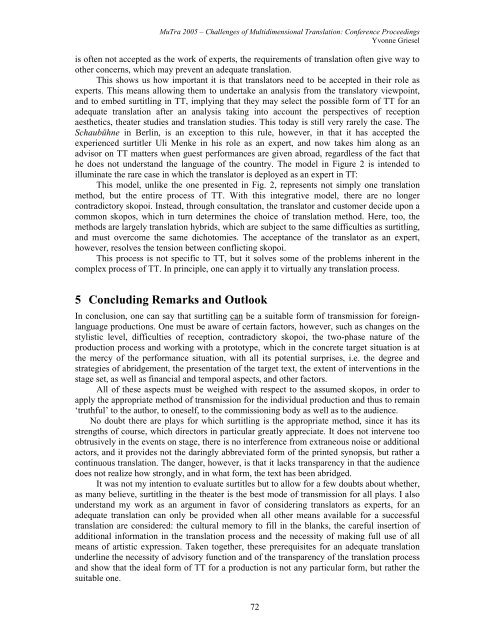Proceedings - Translation Concepts
Proceedings - Translation Concepts
Proceedings - Translation Concepts
Create successful ePaper yourself
Turn your PDF publications into a flip-book with our unique Google optimized e-Paper software.
MuTra 2005 – Challenges of Multidimensional <strong>Translation</strong>: Conference <strong>Proceedings</strong><br />
Yvonne Griesel<br />
is often not accepted as the work of experts, the requirements of translation often give way to<br />
other concerns, which may prevent an adequate translation.<br />
This shows us how important it is that translators need to be accepted in their role as<br />
experts. This means allowing them to undertake an analysis from the translatory viewpoint,<br />
and to embed surtitling in TT, implying that they may select the possible form of TT for an<br />
adequate translation after an analysis taking into account the perspectives of reception<br />
aesthetics, theater studies and translation studies. This today is still very rarely the case. The<br />
Schaubühne in Berlin, is an exception to this rule, however, in that it has accepted the<br />
experienced surtitler Uli Menke in his role as an expert, and now takes him along as an<br />
advisor on TT matters when guest performances are given abroad, regardless of the fact that<br />
he does not understand the language of the country. The model in Figure 2 is intended to<br />
illuminate the rare case in which the translator is deployed as an expert in TT:<br />
This model, unlike the one presented in Fig. 2, represents not simply one translation<br />
method, but the entire process of TT. With this integrative model, there are no longer<br />
contradictory skopoi. Instead, through consultation, the translator and customer decide upon a<br />
common skopos, which in turn determines the choice of translation method. Here, too, the<br />
methods are largely translation hybrids, which are subject to the same difficulties as surtitling,<br />
and must overcome the same dichotomies. The acceptance of the translator as an expert,<br />
however, resolves the tension between conflicting skopoi.<br />
This process is not specific to TT, but it solves some of the problems inherent in the<br />
complex process of TT. In principle, one can apply it to virtually any translation process.<br />
5 Concluding Remarks and Outlook<br />
In conclusion, one can say that surtitling can be a suitable form of transmission for foreignlanguage<br />
productions. One must be aware of certain factors, however, such as changes on the<br />
stylistic level, difficulties of reception, contradictory skopoi, the two-phase nature of the<br />
production process and working with a prototype, which in the concrete target situation is at<br />
the mercy of the performance situation, with all its potential surprises, i.e. the degree and<br />
strategies of abridgement, the presentation of the target text, the extent of interventions in the<br />
stage set, as well as financial and temporal aspects, and other factors.<br />
All of these aspects must be weighed with respect to the assumed skopos, in order to<br />
apply the appropriate method of transmission for the individual production and thus to remain<br />
‘truthful’ to the author, to oneself, to the commissioning body as well as to the audience.<br />
No doubt there are plays for which surtitling is the appropriate method, since it has its<br />
strengths of course, which directors in particular greatly appreciate. It does not intervene too<br />
obtrusively in the events on stage, there is no interference from extraneous noise or additional<br />
actors, and it provides not the daringly abbreviated form of the printed synopsis, but rather a<br />
continuous translation. The danger, however, is that it lacks transparency in that the audience<br />
does not realize how strongly, and in what form, the text has been abridged.<br />
It was not my intention to evaluate surtitles but to allow for a few doubts about whether,<br />
as many believe, surtitling in the theater is the best mode of transmission for all plays. I also<br />
understand my work as an argument in favor of considering translators as experts, for an<br />
adequate translation can only be provided when all other means available for a successful<br />
translation are considered: the cultural memory to fill in the blanks, the careful insertion of<br />
additional information in the translation process and the necessity of making full use of all<br />
means of artistic expression. Taken together, these prerequisites for an adequate translation<br />
underline the necessity of advisory function and of the transparency of the translation process<br />
and show that the ideal form of TT for a production is not any particular form, but rather the<br />
suitable one.<br />
72
















